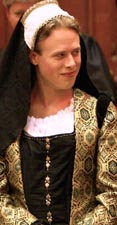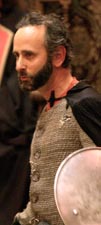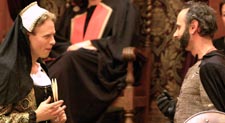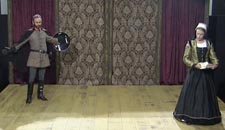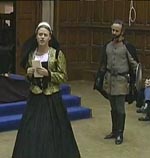- Edition: King Leir
King Leir
- Introduction
- Texts of this edition
- Contextual materials
- Facsimiles
86King Leir, Scene 12
Cast
Gonorill: Matthew Krist
Messenger: Alon Nashman
Cornwall: Jason Gray
Lord: Scott Maynard
Performing Gonorill (Sc. 12)
87Read about performing Gonorill in Scene 10
Matthew Krist (Gonorill) once more made his manipulation of the husband openly apparent to the audience. In this scene, however, the series of tactics he employs do not work. He played the aggrieved little girl ("Alas, my lord..." TLN 952-4), attempted calm reassurance ("I know he is but stol'n..." TLN 956-61), and finally flirted with her husband ("Therefore, my lord, be frolic..." TLN 962-3) but to no avail. His character is forced to take the extreme measure of intercepting the Messenger. The archness of Krist's performance gave the character the quality of a pantomime villainess.
Matthew built on his interpretation of his character's sexuality in this scene, using his sexual charms to persuade the Messenger to risk his life in his character's service. The scene between him and Alon Nashman (Messenger) was highly charged and Gonorill left the stage fanning herself with her letter.
Read more about performing Gonorill.
Watch video of Scene 12 on the Performing the Queen's Men website. (The video footage is password protected. Click on "Cancel" in the pop-up window to obtain password.)
Performing Cornwall (Sc. 12)
88Read about performing Cornwall in Scene 10
In this scene, Cornwall is more in control of his court and his wife's efforts do not deflect him from his concern that Leir has been mistreated. He does, however, fail to see through his wife's manipulative tactics or connect Leir's sudden departure with the way he was treated by his daughter in Scene 10.. As the play progressed Jason Gray (Cornwall) found it necessary to give his character more substance and move away from the naivety that had worked so well in the earlier scenes.
Read more about performing Cornwall.
Performing the Messenger (Sc. 12)
89The text shifts the character's name from Messenger to Murderer once he is engaged by Ragan to kill her father. When first casting the play it seemed unlikely that a character entitled "Murderer" should be a comic character but on close reading, so many of the lines are intended to elicit laughter that a comic interpretation seemed most appropriate. As I was finalizing the casting I noticed that the character of Mumford -- assigned to the company clown -- disappears from the stage when the Messenger/Murderer appears, making it possible to double the two roles, and assign them to Alon Nashman, SQM's chief comic performer.
90This casting created an opportunity for a virtuoso comic performance and increased my suspicion that these roles might have been devised for Richard Tarlton. In this scene, the Messenger refers to himself as a "handsome man" (TLN 1000), which is possibly an ironic reference to Tarlton's famously funny face - the gag is repeated by Derrick in Famous Victories, a role we can be almost sure was played by Tarlton. The Messenger speaks in colloquial prose comparable to Derrick's and his reference to the oyster-wives of Billingsgate (TLN 1023) and his parish neighbours implies he is a London local. Tarlton was a familiar figure in London and his clowning often played off his identity outside of the theatre, blurring the distinction between man and clown.
91My obsession with Tarlton and this role created problems in the rehearsal room for Alon Nashman who had a different reading of the character from my own. Alon saw the Messenger as a wily, sexually aware, and upwardly mobile courtier, who seizes on the queen's favor to secure his personal advancement. I felt he was a less sophisticated operator, a working class lad who stumbles into royal favor and clumsily negotiates his progression to wealth and influence with a directness that derives from the streets rather than from courtly politics. There is plenty of evidence in the text to support the two interpretations and Alon's performance ultimately contained elements of both.
92Working this scene specifically, I looked for ways to bring out the comedy of the interaction right from the start. Tarlton was famous for his entrances and exits and with this in mind, I directed Alon to hurry onto the stage carrying his letter before him and a sense of urgent self-importance, only to turn around and exit via the other curtain (TLN 989). Gonorill called him back creating a comic false exit and double-take. (This effect is not apparent in the PQM video as the stage configuration for this performance forced the actors to change the blocking.) Alon instinctively focused his attention on Gonorill, the potential source of his social advancement, but I encouraged him to develop a closer relationship with the audience. When Gonorill opens his letters, Alon first communicated his shock to the audience with a facial expression before addressing the queen directly (TLN 995). He later used the reference to himself as a "handsome man" as an opportunity to flirt with the audience. Our rehearsal process involved a constant negotiation between Alon's focus on his character's objective and my desire to see the scene clowned to the audience.
93Alon felt the sexual overtones in the Messenger's speech were the mark of a man confident in his sexuality and willing to use it to manipulate the queen. I felt that the colloquial phrasing of his speech such as lines 1011-1016 kept him fixed in the material world of the clown rather than the sophisticated courtier and that it should be played as a clumsy rather than wily approach to the queen. In the final performance, Alon uses his sexual charms on the queen but also manages to involve the audience and engage them with the fun behind crassness of his language.
94At line 1030, the Messenger suddenly adopts verse and sounds like a courtier rather than a clown from the streets of London. He has more speeches in this vein later in the play that all lend weight to Alon's interpretation of the character. Alon played up the double entendre on the word "try me," noted in the textual commentary, and his performance of the line portrayed the character as a wily and sophisticated social climber. In his next speech, however, the Messenger describes the effect of his slanderous tongue comparing its work to the skinning of a rabbit, a colloquial reference that implies the character's connection to the world of the working man or clown, and perhaps also the world of the con artist or "cony catcher". The specific reference to the rabbit ( cony) encourages such a reading.
95At the end of the scene, I wanted Alon to dash off following his line: "I fly, I fly" (TLN 1060). I thought this might have been an opportunity for Tarlton, if he played this role, to create one of his famous comic exits. Alon created his own comic exit by slowly strolling off the stage. The incongruity between line and action was amusing and spoke to his character's confidence and on-going flirtation with the queen.
Read more about performing the Messenger.
Watch video of Scene 12 on the Performing the Queen's Men website. (The video footage is password protected. Click on "Cancel" in the pop-up window to obtain password.)

